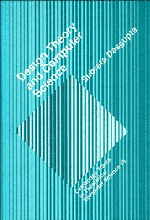Book contents
- Frontmatter
- Contents
- Preface
- Acknowledgements
- Part I The Architectonics of Design
- Part II Design Paradigms
- 6 The Concept of a Design Paradigm
- 7 The Analysis–Synthesis–Evaluation Paradigm
- 8 The Formal Design Paradigm
- 9 The Theory of Plausible Designs
- 10 Design and Artificial Intelligence
- 11 Algorithms for Design
- Part III Design and Science
- References
- Index
9 - The Theory of Plausible Designs
Published online by Cambridge University Press: 10 February 2010
- Frontmatter
- Contents
- Preface
- Acknowledgements
- Part I The Architectonics of Design
- Part II Design Paradigms
- 6 The Concept of a Design Paradigm
- 7 The Analysis–Synthesis–Evaluation Paradigm
- 8 The Formal Design Paradigm
- 9 The Theory of Plausible Designs
- 10 Design and Artificial Intelligence
- 11 Algorithms for Design
- Part III Design and Science
- References
- Index
Summary
INTRODUCTION
Let us recapitulate some of the very basic features of the design process as articulated in Part I of this book.
(a) The requirements constituting the specification of a design problem may (initially) be neither precise nor complete; hence the elaboration of requirements becomes an integral part of the design process. Requirements may, furthermore, be of an empirical or a conceptual nature.
(b) A design is an abstract description of the target artifact that serves as a blueprint for implementation, and as a medium for criticism, experimentation and analysis.
(c) The designer is constantly faced with the problem of bounded rationality – the fact that designers and their clients are limited in their capacities to make fully rational decisions, or are limited in their ability to grasp the full implications of such decisions.
(d) Design decisions are more often than not satisficing procedures.
As a consequence of all of the above design can be naturally viewed as an evolutionary process possessing the following characteristics: at any stage of its development the design is viewed as a tentative or conjectural solution to the problem posed. The designer's task in each evolutionary cycle is to elaborate either the design or the requirements so as to establish or converge towards a fit between the two. Thus, an integral part of each evolutionary cycle is the critical testing of the ‘current’ design against the ‘current’ requirements (see chapter 5, especially section 5.3).
- Type
- Chapter
- Information
- Design Theory and Computer Science , pp. 233 - 276Publisher: Cambridge University PressPrint publication year: 1991



